The Top 5 Autism Management Techniques for Parents
The Top 5 Autism Management Techniques for Parents
Understanding and managing autism requires a blend of empathy, structure, and strategic interventions. Based on extensive experience in developmental pediatrics, here are in-depth strategies for five key areas to support individuals with autism effectively.
1. Creating a Structured Environment
Establishing a structured environment is fundamental when managing autism. Routine offers predictability, which significantly reduces anxiety for individuals with autism. Here’s how to create a structured environment that works:
Establishing Routines:
Daily routines provide a sense of stability and security. Set consistent times for activities such as meals, schoolwork, and bedtime. Visual schedules or charts can outline these routines, making them easier to follow. It’s essential for all caregivers and environments to maintain consistency. This uniformity helps reinforce the routine, creating a stable and predictable environment for your loved one.
I remember working with a young boy who thrived once we implemented a clear, visual daily schedule. His anxiety levels dropped, and his focus improved remarkably.
Using Visual Aids and Tools:
Visual aids are invaluable in helping individuals with autism understand and follow routines. Picture cards can break down tasks into manageable steps, making transitions smoother. Digital apps designed for scheduling can also be effective. By providing a visual representation of the day’s activities, you help your loved one navigate their day with more confidence and less anxiety.
Adapting the Physical Environment:
The physical environment plays a significant role in comfort and focus. Adapting this environment to minimize sensory overload is crucial. Soft lighting can reduce glare and harsh shadows, creating a calming atmosphere. Quiet spaces free from loud, sudden noises can provide a retreat when overstimulation occurs. Organized areas where everything has its place can help reduce stress and improve concentration. Simple changes like these can make your home more accommodating and supportive.
Practical Tips for Consistency:
- Daily Schedule: Create a daily schedule that includes all routine activities. Hang it in a visible place so your loved one can refer to it throughout the day.
- Consistent Bedtime Routine: Develop a bedtime routine that includes calming activities like reading or listening to soft music. Stick to the same bedtime each night.
- Mealtime Structure: Serve meals at the same times each day. Use the same seating arrangement and mealtime routines to provide familiarity.
Engaging Your Loved One in Creating Routines:
Involve your loved one in creating their routines. This engagement can give them a sense of control and ownership, making them more likely to follow the routines. Ask for their input on activities and preferences to suit their needs and interests.
2. Enhancing Communication
Effective communication is crucial for understanding and supporting individuals with autism. Here are strategies to enhance communication:
Understanding Communication Needs:
Every individual with autism has distinct communication preferences. Some might rely on non-verbal methods, while others use verbal communication or technology-assisted tools. Observing and understanding these preferences is key to effective communication. Pay attention to their cues and be flexible in your approach.
Using Visual Supports:
Visual supports like picture boards, sign language, or apps are essential in bridging communication gaps. These tools enhance understanding and expression, making it easier for the individual to communicate their needs and feelings. Incorporate these supports into daily routines to foster consistent and effective communication.
Encouraging Expression:
Create opportunities for your loved one to express themselves. Use simple, clear language and be patient, allowing them time to process and respond. Encourage them to use their preferred communication method, whether it’s speaking, using pictures, or a communication device. Celebrate their efforts to communicate, no matter how small.
Practical Tips for Enhancing Communication:
- Routine Communication: Incorporate communication opportunities into daily routines, such as during meals or playtime.
- Modeling Communication: Model appropriate communication behaviors by using visuals to support yourself.
- Listening Actively: Show that you are listening by maintaining eye contact and responding appropriately to their attempts to communicate.
I once worked with a family where the child preferred using a communication app. The joy and confidence in his eyes when he was able to express himself clearly was unforgettable.
Engaging Your Loved One in Communication:
Involve your loved one in choosing their communication tools and methods. This involvement can empower them and make them more willing to engage in communication. Ask for their preferences and make adjustments based on their feedback.
3. Positive Reinforcement Techniques
Positive reinforcement is a powerful tool for encouraging desired behaviors. Here’s how to use it effectively:
Identifying Motivators:
Positive reinforcement depends on understanding what motivates the individual. This could be verbal praise, favorite activities, or tangible rewards. Pay attention to what they enjoy and use these motivators to encourage positive behavior.
Consistency in Reinforcement:
Reward positive behavior consistently and immediately. This establishes a clear link between the behavior and the reward, reinforcing the desired actions. Consistent reinforcement helps in developing a predictable and supportive environment.
Building on Success:
Start with small, achievable goals and gradually increase expectations as positive behaviors become more frequent. This approach builds confidence and encourages continuous improvement. Celebrate each success to maintain motivation and enthusiasm.
Practical Tips for Positive Reinforcement:
- Immediate Rewards: Give rewards immediately after the desired behavior to strengthen the connection.
- Variety of Rewards: Use a variety of rewards to keep the individual engaged and motivated.
- Clear Expectations: Set clear expectations for behavior and consistently reinforce them.
One young girl I worked with responded amazingly to positive reinforcement. Her favorite reward was extra playtime with her favorite toy, and this simple method transformed her behavior over time.
Engaging Your Loved One in Positive Reinforcement:
Involve your loved one in identifying their motivators. Ask them what they enjoy and how they would like to be rewarded. This involvement can increase their motivation and willingness to engage in positive behaviors.
4. Managing Sensory Needs
Sensory management is essential for the comfort and well-being of individuals with autism. Here’s how to manage sensory needs effectively:
Identifying Sensory Triggers:
Sensory sensitivities vary greatly among individuals with autism. Identifying what causes discomfort—such as loud noises, bright lights, or certain textures—is essential. Pay attention to their reactions to different sensory inputs. This understanding helps in creating a more comfortable environment.
Creating Sensory-Friendly Spaces:
Design spaces that cater to these sensory needs. Quiet rooms, sensory corners with calming activities, or sensory integration equipment can help manage sensory overload. Soft lighting, soundproofing, and organized spaces can make a significant difference. These adaptations create safe havens where your loved one can retreat and regulate their sensory input.
Incorporating Sensory Activities:
Provide activities that address sensory needs. Swinging, squeezing stress balls, or using weighted blankets can be calming. These activities help in self-regulation and can be integrated into daily routines. Encourage your loved one to use these activities when they feel overwhelmed.
Practical Tips for Sensory Management:
- Sensory Breaks: Include sensory breaks in daily routines to help manage overload.
- Personal Sensory Toolkit: Create a sensory toolkit with items that help calm and focus, such as fidget toys or noise-canceling headphones.
- Monitor Reactions: Keep track of what sensory activities and environments work best for your loved one.
Engaging Your Loved One in Sensory Management:
Involve them in selecting sensory activities and tools. This engagement can increase their comfort and willingness to use these strategies. Ask for their preferences and observe what works best.
5. Developing Social Skills
Social skills are essential for building relationships and navigating social environments. Here’s how to support social skills development:
Structured Social Training:
Social skills can be challenging for individuals with autism. Structured training, such as role-playing and social stories, can teach appropriate social interactions. These methods provide clear examples and practice opportunities.
Encouraging Peer Interaction:
Gradually introduce group activities, allowing the individual to participate at their own pace. Positive peer interactions can boost social skills and confidence. Start with small groups and simple activities, gradually increasing complexity.
Using Social Stories:
Social stories illustrate social situations and appropriate responses. Tailor these stories to specific scenarios your loved one might encounter. These narratives help in understanding social cues and expected behaviors.
Practical Tips for Social Skills Development:
- Role-Playing: Practice social situations through role-playing to prepare for real-life interactions.
- Consistent Practice: Regularly engage in social skills training to reinforce learning.
- Positive Feedback: Provide positive feedback and encouragement to build confidence.
Engaging Your Loved One in Social Skills Training:
Involve them in creating social stories and role-playing scenarios. This involvement makes the training more relevant and engaging. Ask for their input and adapt based on their feedback.
I recall a time when role-playing helped a teenage girl gain the confidence to join a school club. The transformation in her social interactions was a joy to witness.
Creating a Supportive and Structured Future
Managing autism with love and strategy involves understanding the unique needs of each individual and providing a supportive, structured environment. By focusing on creating routines, enhancing communication, using positive reinforcement, managing sensory needs, and developing social skills, caregivers can significantly improve the quality of life for individuals with autism. Celebrating progress and fostering independence are key to helping them reach their full potential and lead fulfilling lives. The journey may have its challenges, but with the right tools and strategies, it is possible to navigate it successfully.
Take the Next Step with Compassionate Support
Navigating the journey of autism can be challenging, but you don’t have to do it alone. At Developmental Pediatrics, we’re here to provide the support and guidance you need. Our team of experts is dedicated to helping you create a nurturing and effective environment for your loved one. Reach out to us today to take the first step towards a brighter future. Contact us to learn more about our services and how we can assist you in this journey. Together, we can make a difference.
Remember, every step forward is a step towards a better tomorrow for your loved one. Let’s take those steps together.
>>CTA BUTTON<<
Common Questions for Autism Management Techniques
1. How can daily routines help in managing autism effectively?
Daily routines offer predictability and structure, which can significantly reduce anxiety for individuals with autism. Consistent schedules for activities like meals, schoolwork, and bedtime create a stable environment. Visual schedules and charts can aid in outlining these routines, making them easier to follow and understand.
2. What are some effective communication strategies for children with autism?
Effective communication strategies for children with autism include understanding their unique communication preferences, using visual supports like picture boards and communication apps, and creating opportunities for expression. Encouraging the use of preferred communication methods and celebrating their efforts fosters better understanding and connection.
3. How can sensory management improve the comfort and well-being of individuals with autism?
Sensory management involves identifying sensory triggers and creating sensory-friendly spaces. Quiet rooms, sensory corners with calming activities, and tools like weighted blankets and fidget toys can help manage sensory overload. Incorporating these strategies into daily routines helps in self-regulation and reduces anxiety.



